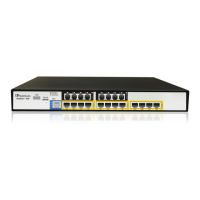18:38:14. 52 : 10.33.45.72 : NOTICE:
[S=235][SID:1034099026] (lgr_psbrdex)(619)
recv <-- DIGIT(0) Ch:0 OnTime:0
InterTime:100 Direction:0 System:1 [File:
Line:-1]
18:38:14. 83 : 10.33.45.72 : NOTICE:
[S=236][SID:1034099026] (lgr_flow)(620)
#0:DIGIT_EV [File: Line:-1]
18:38:14. 83 : 10.33.45.72 : NOTICE:
[S=237][SID:1034099026] (lgr_flow)(621) |
#0:DIGIT_EV [File: Line:-1]
18:38:14.958 : 10.33.45.72 : NOTICE:
[S=301][SID:1034099026] (lgr_flow)(625) |
Log Number
(lgr)(number)
Ignore this number; it has been replaced by the Message
Sequence Number (described previously).
Session ID
Automatically assigned (random), unique session identifier
(session-id / SID) number per call in the CDR of sent Syslog
messages and debug recording packets. This enables you to
filter the information (such as SIP, Syslog, and media)
according to the SID.
Gateway/IP-to-IP application: A call session is considered
either as a Tel-to-IP leg or an IP-to-Tel leg, where each leg
is assigned a unique SID.
SBC application: A session is considered as both the
outgoing and incoming legs, where both legs share the
same SID.
The benefit of this unique numbering is that it enables you to
filter the information (such as SIP, Syslog, and media)
according to a specific SID.
Note: Forked legs and alternative legs share the same SID.
Message Body
Describes the message.
Timestamp
When the Network Time Protocol (NTP) is enabled, a
timestamp string [hour:minutes:seconds] is added to all
Syslog messages.
60.1.1 Event Representation in Syslog Messages
The Syslog message events that the device sends are represented by unique
abbreviations. An example of an abbreviated event in a Syslog message indicating packet
loss (PL) is shown below:
Apr 4 12:00:12 172.30.1.14 PL:5 [Code:3a002] [CID:3294] [Time:
20:17:00]

